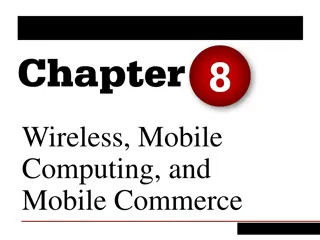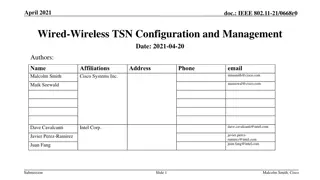Understanding Wireless Networks: Types and Applications
Wireless networks utilize wireless data connections to connect network nodes and share resources. They include Wireless Personal Area Networks (WPAN), Wireless LAN, Wireless WAN, Wireless Broadband, and Wireless Cellular. Each type has specific characteristics and applications, such as linking personal devices, covering buildings or cities, transmitting large amounts of data quickly, and enabling mobile data transmission. Wireless LAN applications help extend wired LANs when it's challenging to use wired technologies.
Download Presentation

Please find below an Image/Link to download the presentation.
The content on the website is provided AS IS for your information and personal use only. It may not be sold, licensed, or shared on other websites without obtaining consent from the author. Download presentation by click this link. If you encounter any issues during the download, it is possible that the publisher has removed the file from their server.
E N D
Presentation Transcript
CT1303 LAN Rehab AlFallaj
WIRELESS NETWORK Is any type of computer network that uses wireless data connections for connecting network nodes and sharing network resources. So, it differs than previous network with, the type of transmission media, wireless transmission media. Microwave. Infrared. Laser.
WIRELESS NETWORK Wireless network based on its covered and its bandwidth used in its channel frequencies. Wireless Personal Area Network (WPAN) . Wireless LAN . Wireless WAN . Wireless Broadband . Wireless Cellular .
WIRELESS PERSONAL AREA NETWORK (WPAN) Used to link or connect personal devices (PDA Personal Data Assistant), printers, mobile devices embedded in computers. One hall, room Controlled by 1 person owned the network. Microwave, Infrared waves.
WIRELESS LAN Covers a building, or more. Connects personal computers, Notebooks, printers, storage devices wirelessly. Controlled by 1 person or more. Microwave, Infrared waves.
WIRELESS WAN Covered wider geographical area, cities, countries. Links and connects computers among different cities wirelessly by Satellite. Controlled by international organization or government or big telecommunication companies.
WIRELESS BROADBAND Covers a city. Connects computers wirelessly. Mainly used to transmit large amounts of data very fast, Ex: Video films, Photos, websites. Broadband microwaves, laser. Controlled by organization or government.
WIRELESS CELLULAR Used mostly for mobiles, but now can be used for data transmission. Can connect computers, connect to Internet. Can be used in a wide area. Controlled by companies or government.
WIRELESS LAN APPLICATIONS To extend LAN. Sometimes it is difficult to extend a wired LAN, so wireless technologies can help. To connect two to more LANs.
WIRELESS LAN APPLICATIONS Advantages: Decrease cost of the new extension. Easy to change.
WIRELESS LAN APPLICATIONS Serve mobile devices, laptops, notebooks.
WIRELESS LAN APPLICATIONS Build a temporary network. Military camps. Relief camps. conferences. Usually this type of temporary networks have a changing topology ( not fixed or has a permanent topology).
CHALLENGES AND OBSTACLES OF WIRELESS NETWORKS Radio and microwaves and infrared waves is more prone to the interference. Data transmission is not %100 guaranteed. Attenuation and fading of waves and signals may occur. Privacy security concerns. The limitation of the bandwidth, and the huge number of people connecting with this network demanding the need to manage and granting the right to broadcast to eliminate interference if waves.
CHALLENGES AND OBSTACLES OF WIRELESS NETWORKS Usually transmission rate becomes lower (based on Nyqist rule) when huge number of Subscribers are there. The limitation of the power that supplies wireless devices , protocols should be made based on it. Hidden node and Exposed node .
CHALLENGES AND OBSTACLES OF WIRELESS NETWORKS
MAIN STRUCTURE OF WIRELESS LANS Add-hoc WLAN . Routers pass/forwards signals and data. Service nodes. A network with a changing and random nature. Topology cab change Basic Service Set (BSS)
MAIN STRUCTURE OF WIRELESS LANS Multicells wireless networks . Many access points AP connect computers. These AP connected through channel or wired network Distributed Systems Extended Service Set ESS
WIRELESS NETWORK STANDARDS Institute of Electrical & Electronic Engineers IEEE, The European Telecommunications Standards Institute ETSI, and forums of companies and factories that manufacture these network devices (ex: Bluetooth forum). 204 GHz 5 GHz frequencies.
WIRELESS NETWORK STANDARDS: BLUETOOTH WIRELESS NETWORK Bluetooth wireless network standards: IBM, INTEL, NOKIA, Ericsson, Toshiba Connect PDAs, printers, mobile devices embedded in computers. Covers 1 hall, room. Controlled by 1 person won this network. Microwave, infrared transmission channel.
WIRELESS NETWORK STANDARDS: WIRELESS LAN STANDARD IEEE, 802.11 project 802.11a , 802.11b, 802.11g It is called Wi-Fi ( commercial name) 802.11 wireless LAN: Transmission rate: 2 Mbps Bandwidth: 2.4 GHz 802.11b wireless LAN: Transmission rate: 11 Mbps Bandwidth: 2.4 GHz
WIRELESS NETWORK STANDARDS: WIRELESS LAN STANDARD 802.11a wireless LAN: Transmission rate: 54 Mbps Bandwidth: 5 GHz 802.11g wireless LAN: Transmission rate: 54 Mbps Bandwidth: 2.4 GHz Compatible with 802.11b
WIRELESS NETWORK STANDARDS: WIRELESS MAN STANDARD IEEE, 802.16 project 802.16: Line of sight transmission rate: 134 Mbps Bandwidth: 10-66 GHz. Wi-MAX 802.16a: Line of sight transmission rate: 70 Mbps Bandwidth: 2-11 GHz.
WIRELESS NETWORK STANDARDS: WIRELESS MAN STANDARD
WIRELESS SENSOR NETWORK For specific purposes, use sensing and digital controlling. Used for Remote Sensing application, ex: factories, radar application, hospitals. 802.15.3 standards: Transmission using: Ultra Wide Band (UWB), transmission with lower power with a very high broadband. No interference and noise.
WIRELESS LAN PROTOCOLS Due to noise, interference, hidden and exposed nodes; CSMA can t be used effectively in wireless LANs. Aloha can be used. Multiple Access with Collision Avoidance MACA; similar to CSMA/DA Multiple Access with Collision Avoidance for Wireless MACAW. Collisions can be detected at receiver device. Transmission by Request To Send frame (RTS) and Confirm To Send frame (CTS).
WIRELESS LAN PROTOCOLS Waiting time after collision is equal with all waiting nodes. ACK is used to confirm receiving the data correctly. RTS CTS DATA ACK























